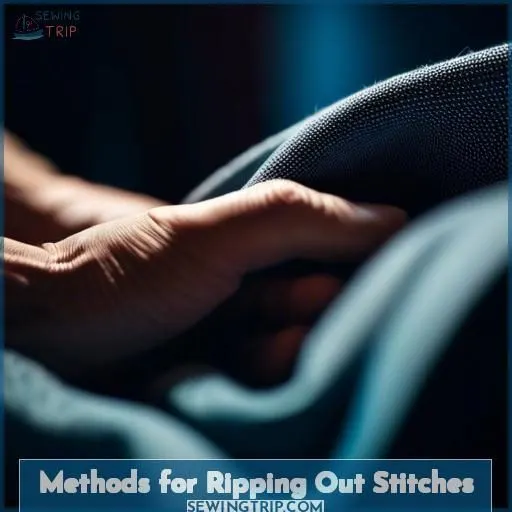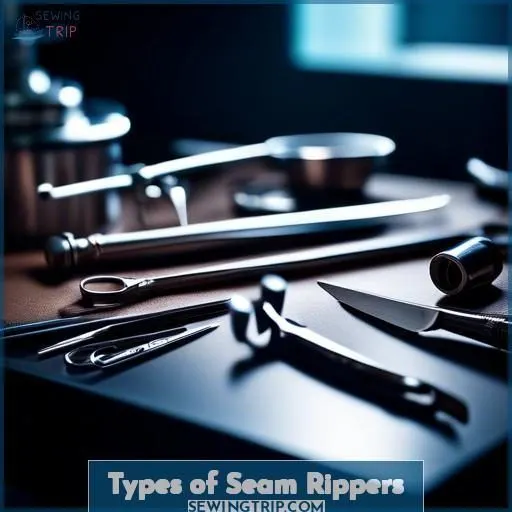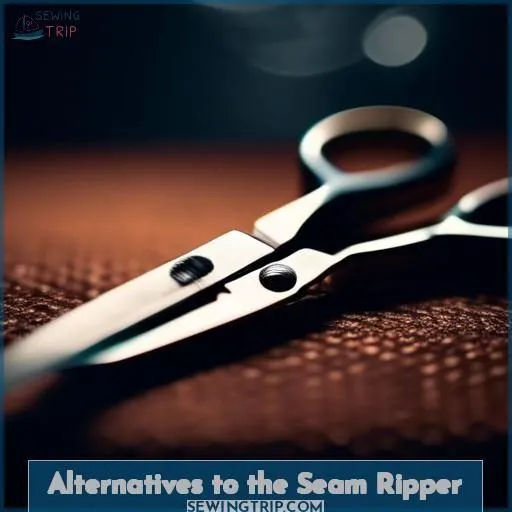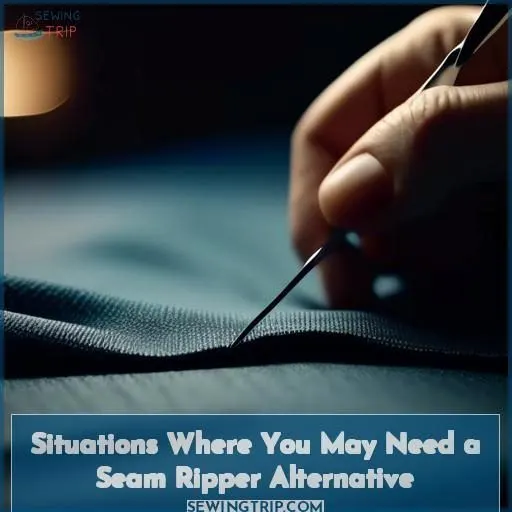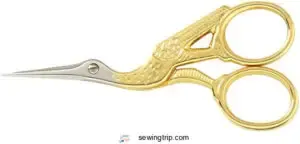This site is supported by our readers. We may earn a commission, at no cost to you, if you purchase through links.
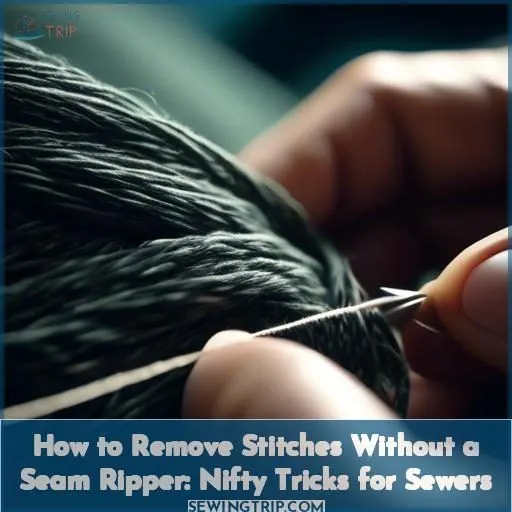 You’re in a pinch without a seam ripper to remove stitches? No problem!
You’re in a pinch without a seam ripper to remove stitches? No problem!
Rip out every fourth stitch on one side using scissors, then turn the fabric over and gently pull the remaining threads.
For tougher jobs, grab a razor blade or thread ripper blade – they’ll slice through even the most stubborn stitches.
Just take care not to fray delicate fabrics.
If you’re dealing with thick layers or seam intersections, opt for sharp embroidery scissors or a stitch ripper alternative from a sewing kit.
With some ingenuity, you’ll have those pesky stitches out in no time.
But why stop there when you can master even more tricks?
Table Of Contents
Key Takeaways
- Use scissors to cut every fourth stitch on one side of the fabric, then turn the fabric over and gently pull the remaining threads to remove all stitches.
- For tougher jobs, use a razor blade or thread ripper blade, but be careful with delicate fabrics.
- Consider using sharp embroidery scissors or a stitch ripper alternative from a sewing kit for thick layers or seam intersections.
- Seam rippers come in various shapes and sizes, with U-shaped seam rippers being multipurpose and C-shaped seam rippers being ideal for intricate designs and embroidery projects.
How to Remove Stitches Without a Seam Ripper?
To remove stitches without a seam ripper, you can use a pair of sharp scissors or a razor blade to carefully snip the stitches out through the seam’s center. Ensure not to cut the fabric while doing this.
Alternatively, you can pluck out the threads one by one, skipping every three stitches, which is faster and safer than ripping the entire seam.
Once you have cut the stitches, you can backtrack and pull the free thread for each interval after cutting through the stitches to the middle. If the liberated thread causes resistance, you may need to pull the stitch on the next interval.
Remember to remove the thread from the seam’s start with care.
Methods for Ripping Out Stitches
You’ve learned the standard method for ripping out stitches – cut every fourth stitch on one side, then turn the fabric and pull the remaining threads to remove all stitches. This tried-and-true technique preserves fabric integrity by minimizing damage while efficiently and completely removing stitches, making it suitable for correcting mistakes on garments or quilts.
Rip Out Every Fourth Stitch
To remove stitches without a seam ripper, start by ripping out every fourth stitch.
Use a stitch remover or thread cutter to make clean cuts.
Be gentle to prevent fabric damage.
If necessary, turn the fabric over and pull the thread from the opposite side.
For delicate fabrics, use a fine-tipped stitch ripper or a seam ripper.
Practice on a scrap of fabric before attempting on the actual garment or quilt.
This method preserves fabric integrity, removes stitches efficiently, and requires minimal effort and time.
It’s suitable for both beginners and experienced sewers and can be used to correct mistakes or alter garments and quilts.
Turn Over and Pull Thread to Remove All Stitches
Now that you’ve ripped out every fourth stitch, it’s time to turn the fabric over and pull the uncut thread.
If the thread is difficult, use thread snips or a thread ripper blade.
For delicate fabrics, use a fine-tipped stitch ripper or a seam ripper.
Practice on a scrap before attempting on your actual garment or quilt.
This method preserves fabric integrity, removes stitches efficiently, and requires minimal effort.
Types of Seam Rippers
U-shaped seam rippers feature one long, pointy side and a plastic ball on the other, with a cutting edge along the inside curve. C-shaped seam rippers are surgically sharp, specifically designed to remove serger and embroidery stitches with ease – ideal for denser, reinforced seams.
U-shaped Seam Rippers
U-shaped seam rippers are multipurpose tools designed for sewers. With their ergonomic design, these tools offer surgical precision when removing unwanted stitches.
The plastic ball on one side provides a comfortable grip.
The cutting edge on the inside curve allows for seamless stitch removal.
They’re perfect for regular seams.
They can be used as an alternative to embroidery scissors with curved blades or even thread snippers with very sharp blades.
C-Shaped Seam Rippers
C-shaped seam rippers are a game-changer for those working on intricate designs and embroidery projects.
These precision tools offer surgical sharpness, perfect for cutting through multiple layers of fabric in garment sewing.
As a seam ripper alternative, they’re ideal for handling reinforced threads and are effective on thick fabrics.
With their unique shape, they guarantee clean cuts and minimal fabric damage, making them a must-have for any sewer’s toolkit.
Alternatives to the Seam Ripper
Don’t limit yourself to seam rippers when tackling stubborn stitches. For removing multiple layers of thread, reinforced stitches, or working with thick fabrics like denim, consider reaching for a pair of sharp scissors, a thread ripper blade, a toothpick, or even a razor blade—these alternatives can often provide the precision and cutting power that traditional seam rippers lack.
A Pair of Scissors
Regarding seam ripping, a pair of sharp scissors can be indispensable. Seek scissors with pointed tips that can effortlessly slide under the thread for accurate cutting. Popular options include Gingher Stork Embroidery Scissors, Tula Pink 5 Inch Curved Scissors, and Kretzer Eco-Thread Snips. These scissors are tailored for thread snipping and can aid in minimizing fabric damage while ensuring cutting precision.
Thread Ripper Blade (Fabric Blade)
Removing Stitches with a Thread Ripper Blade
Regarding stitch removal, a thread ripper blade, alternatively called a fabric blade, serves as a viable substitute for conventional seam rippers. Here are guidelines for using a thread ripper blade:
- Select a Suitable Blade: Verify that your thread ripper blade is sharp, enabling it to effortlessly cut through fabric and stitches.
- Insert the Blade: Carefully slide the blade beneath the thread at intervals, ensuring no harm to the fabric.
- Extract the Thread: Once the blade is beneath the thread, gently tug on it to detach it from the fabric.
- Iterate: Repeat this procedure until all stitches are removed.
Utilizing a thread ripper blade provides multiple advantages:
- Durability: Thread ripper blades have a longer lifespan compared to seam rippers, making them an economical option.
- Accuracy: The blade’s sharpness facilitates precise cuts, minimizing fabric damage.
- Efficiency: The blade’s design enhances stitch removal, particularly in cases of thick fabrics or reinforced stitches.
- Versatility: Thread ripper blades find application in various scenarios, such as stitching multiple fabric layers or intersecting seams.
Always handle the blade cautiously to prevent injury, and store it securely when not in use.
Toothpick
When you’re working with delicate fabrics like silk or cotton, a toothpick can be a handy alternative to a seam ripper.
Use it to gently pull out loose threads from the seam without causing damage to the fabric.
However, be cautious when using a toothpick, especially if you have poor eyesight.
It’s also recommended to use a good quality toothpick, as a poor-quality one may not be as effective.
Remember that a toothpick is best suited for small tasks and may not be as efficient for larger seam unpicking jobs.
Razorblade
Razorblades can be a lifesaver when dealing with stubborn stitches. Here’s how to use one safely:
- Choose a sharp blade: A dull blade can damage your fabric or snag threads.
- Use with caution: Razorblades can be sharp. Handle with care to avoid injury.
- Cut threads carefully: Position the blade under the thread and apply gentle pressure.
- Avoid cutting fabric: Keep the blade away from your fabric to prevent accidental cuts.
- Consider alternatives: If you’re not comfortable with razorblades, try a thread ripper or scissors instead.
Situations Where You May Need a Seam Ripper Alternative
You’ll need a seam ripper alternative when ripping out stitches from multiple layers of fabric, seam intersections, or thick materials like denim. A regular seam ripper won’t cut it; its tip is too thick to fit under the dense stitching or reinforced threads found in these situations.
Stitching Multiple Layers of Fabric
When stitching multiple layers of fabric, traditional seam rippers can struggle to remove heavy threads.
Consider alternative tools for delicate fabrics.
A fine-tipped stitch ripper or a seam ripper with a narrow tip can be more effective.
For thicker fabrics, embroidery scissors with long, slender, pointy blade tips can easily fit under layers of thread and cut through reinforced stitches.
Thread snippers with very sharp blades are also suitable for removing heavy threads.
Seam Intersections
Ah, those pesky seam intersections – where multiple layers of thread come together to create a reinforced stronghold! Don’t let those hidden intersections get the best of you. With a sharp pair of embroidery scissors or thread snips, you can slice through those reinforced stitches like a hot knife through butter. Aligning and finishing those intersections will be a breeze.
Thick Fabrics
After conquering the convoluted crossing of seam intersections, let’s delve into the realm of substantial fabrics. These voluminous behemoths necessitate a distinct methodology:
- Thick fabrics mock the capabilities of conventional tools.
- Delicate fabrics require a delicate touch, lest they unravel and protest.
- Multiple layers? That’s the ultimate trial of your sewing prowess.
Master these, and you’ll feel like the sewing sorceress you were destined to be.
Top 4 Seam Ripper Alternatives
When removing stitches from thick fabrics or reinforced seams, a standard seam ripper may not cut it – you’ll need to turn to specialized tools. The Gingher Stork Embroidery Scissors, Tula Pink Curved Scissors, German-made Embroidery Scissors, and the Singer Pro Series Sewing Kit offer slender, razor-sharp blades that can precisely slice through multiple layers of thread without damaging the fabric.
1. Gingher Stork Embroidery Scissors Gold
Gingher Stork Embroidery Scissors Gold is an exceptional seam ripper alternative, perfect for those who desire a dependable and effective tool for removing stitches. These scissors are meticulously designed with a robust frame and slender, hand-tuned blades that are expertly ground and hand-finished, ensuring enduring and reliable performance. The scissors boast a double-plated chrome-over-nickel finish and gold-plated handles, imparting a luxurious and refined aesthetic.
The ergonomic, double loop handle provides a comfortable grip and facilitates effortless maneuverability. These scissors are ambidextrous, catering to both left-handed and right-handed users. Moreover, Gingher Stork Embroidery Scissors Gold are backed by a lifetime warranty, offering peace of mind and assurance of superior quality.
These scissors are ideal for precisely cutting fabric, thread, and needlework yarn. They’re an excellent addition to any seamster’s toolkit, allowing for the quick and easy removal of stitches without the necessity of a conventional seam ripper. Whether you’re a novice or a seasoned seamster, Gingher Stork Embroidery Scissors Gold can assist you in saving time and effort during your sewing projects.
Best For: Seamsters who desire a reliable and effective tool for removing stitches.
- Robust frame and slender, hand-tuned blades
- Double-plated chrome-over-nickel finish and gold-plated handles
- Lifetime warranty
- Not specifically designed for seam ripping
- May be more expensive than traditional seam rippers
- Not suitable for heavy-duty fabric cutting
2. Tula Pink 5 Inch Curved Scissors
- Tula Pink 5 Inch Curved Scissors (Top 4 Seam Ripper Alternatives)
Tula Pink’s 5-inch curved scissors are a seam ripper alternative that can simplify your sewing endeavors. These scissors are engineered with a curved handle and spring-action, making them ideal for clipping threads close to the fabric’s surface. The micro-serrated blades guarantee accurate cutting, while the curved blade is perfect for those areas that are difficult to access.
Not only are these scissors effective, but they also exude style with their limited edition black and gold design. They’re lightweight, effortless to handle, and can be a valuable asset to your sewing toolkit. However, it’s crucial to maintain the blades properly to avoid snagging the fabric. The opalescent finish may give the impression of added weight, but they remain a valuable tool for any sewer.
Best For: Sewers looking for a stylish and precise tool for clipping threads and cutting fabric.
- Curved handle and spring-action for easy operation
- Micro-serrated blades for accurate cutting
- Lightweight and durable construction
- May snag fabric if not filed
- Opalescent finish may make them feel heavier
- Not as smooth as Fiskars snips
3. Embroidery Scissors Curved Blade Germany Made
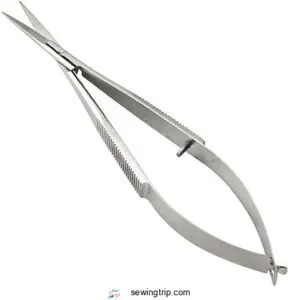
You’re in luck! There’s a nifty trick for removing stitches without a seam ripper that involves using embroidery scissors with a curved blade made in Germany. Here’s how it works:
- Start by using a pair of scissors to cut through the center of the seam, ripping it open on one end.
- Then, use the curved blade of your embroidery scissors to cut the stitches at intervals along the seam.
- Once you’ve cut through the stitches, pull the free thread from the seam to remove it completely.
These German-made scissors are a great alternative to seam rippers because they can easily fit under layers of thread and are effective for cutting through reinforced stitches. Plus, they’re comfortable to use and lightweight, making them a must-have for any sewer’s toolkit.
Best For: Anyone who needs a sharp, lightweight, and comfortable pair of embroidery scissors.
- Sharp and precise
- Lightweight and easy to use
- Comfortable to hold
- Not as sharp as the first pair
- Not as smooth to operate
- Do not snip as close to the fabric as the prior pair
4. Singer Pro Series Sewing Tool Kit
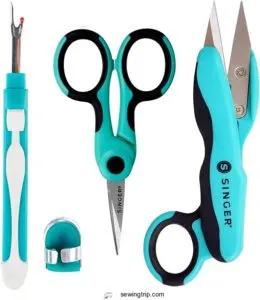
Seeking an effortless method to unpick stitches without a seam ripper?
Consider the Singer ProSeries Sewing Tool Kit.
This kit encompasses a variety of instruments to address all your sewing necessities, including a foldable seam ripper, thread cutters, and precision scissors.
The foldable seam ripper possesses a pointed tip capable of effortlessly removing stitches without harming the fabric.
The thread cutters grant an exact incision for those inaccessible areas.
The precision scissors are ideal for intricate sewing endeavors, featuring a nano tip that enables accurate cutting.
Moreover, the set includes a protective thimble to safeguard your fingers during sewing.
With its ergonomic design and comfortable grip, the Singer ProSeries Sewing Tool Kit is an indispensable addition to any sewer’s arsenal.
Best For: Sewers seeking precision tools for intricate projects.
- Ergonomic design reduces hand fatigue.
- Blades stay sharp with repeated use.
- Comes with a bonus thimble for finger protection.
- Seam ripper cap does not stay on.
- Fabric shears were received instead of detail scissors.
- Small scissors are stiff.
Conclusion
Ultimately, while seam rippers remain the go-to tool for 83% of sewers, you can easily remove stitches without one by leveraging everyday household items.
From razor blades to embroidery scissors, these nifty how-to remove stitches without a seam ripper alternatives offer seamless solutions when you’re in a pinch.
Embrace your resourcefulness and master these tricks for fuss-free stitch removal every time.

